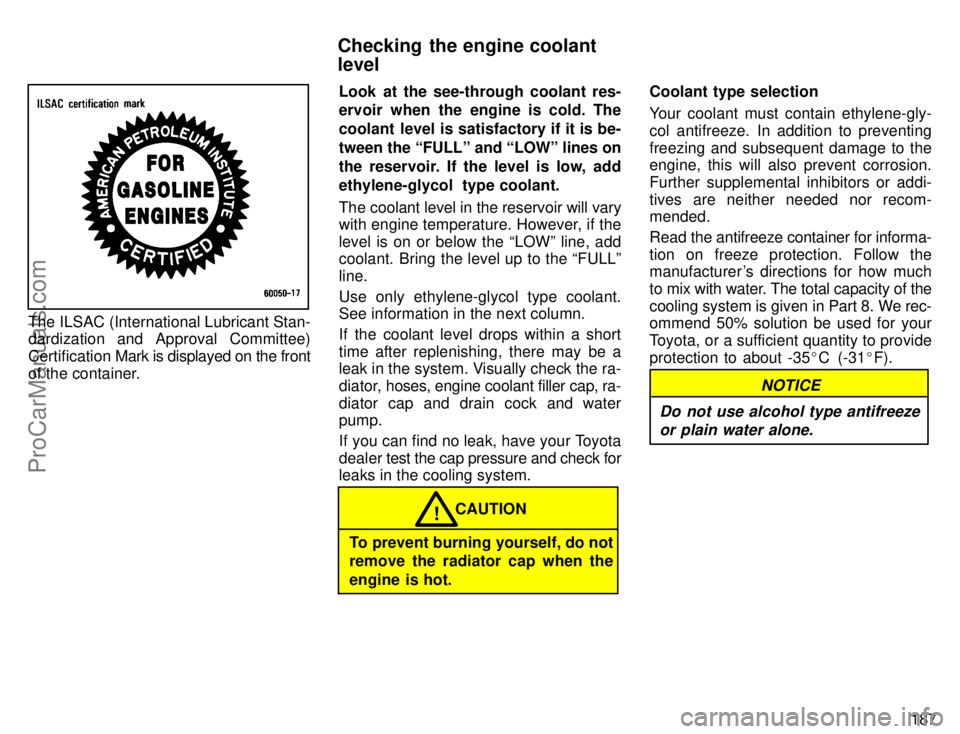Page 193 of 226

187
The ILSAC (International Lubricant Stan-
dardization and Approval Committee)
Certification Mark is displayed on the front
of the container.Look at the see-through coolant res-
ervoir when the engine is cold. The
coolant level is satisfactory if it is be-
tween the FULLº and LOWº lines on
the reservoir. If the level is low, add
ethylene-glycol type coolant.
The coolant level in the reservoir will vary
with engine temperature. However, if the
level is on or below the LOWº line, add
coolant. Bring the level up to the FULLº
line.
Use only ethylene-glycol type coolant.
See information in the next column.
If the coolant level drops within a short
time after replenishing, there may be a
leak in the system. Visually check the ra-
diator, hoses, engine coolant filler cap, ra-
diator cap and drain cock and water
pump.
If you can find no leak, have your Toyota
dealer test the cap pressure and check for
leaks in the cooling system.
CAUTION!
To prevent burning yourself, do not
remove the radiator cap when the
engine is hot.Coolant type selection
Your coolant must contain ethylene-gly-
col antifreeze. In addition to preventing
freezing and subsequent damage to the
engine, this will also prevent corrosion.
Further supplemental inhibitors or addi-
tives are neither needed nor recom-
mended.
Read the antifreeze container for informa-
tion on freeze protection. Follow the
manufacturer 's directions for how much
to mix with water. The total capacity of the
cooling system is given in Part 8. We rec-
ommend 50% solution be used for your
Toyota, or a sufficient quantity to provide
protection to about -35�C (-31�F).
NOTICE
Do not use alcohol type antifreeze
or plain water alone.
Checking the engine coolant
level
ProCarManuals.com
Page 199 of 226

193 WHEN TO REPLACE YOUR WHEELS
If you have wheel damage such as
bending, cracks or heavy corrosion,
the wheel should be replaced.
If you fail to replace damaged wheels, the
tire may slip off the wheel or they may
cause loss of handling control.
WHEEL SELECTION
When replacing wheels, care should
be taken to ensure that the wheels are
replaced by ones with the same load
capacity, diameter, rim width, and off-
set.
This must be observed on compact spare
tires, too.
Correct replacement wheels are available
at your Toyota dealer.
A wheel of a different size or type may ad-
versely affect handling, wheel and bear-
ing life, brake cooling, speedometer/
odometer calibration, stopping ability,
headlight aim, bumper height, vehicle
ground clearance, and tire or snow chain
clearance to the body and chassis.Replacement with used wheels is not rec-
ommended as they may have been sub-
jected to rough treatment or high mileage
and could fail without warning. Also, bent
wheels which have been straightened
may have structural damage and there-
fore should not be used. Never use an in-
ner tube in a leaking wheel which is de-
signed for a tubeless tire.�After driving your vehicle the first 1600
km (1000 miles), check that the wheel
nuts are tight.
�If you have rotated, repaired, or
changed your tires, check that the
wheel nuts are still tight after driving
1600 km (1000 miles).
�When using tire chains, be careful not
to damage the aluminum wheels.
�Use only the Toyota wheel nuts and
wrench designed for your aluminum
wheels.
�When balancing your wheels, use only
Toyota balance weights or equivalent
and a plastic or rubber hammer.
�As with any wheel, periodically check
your aluminum wheels for damage. If
damaged, replace immediately.
Aluminum wheel precautions Replacing wheels
ProCarManuals.com
Page 217 of 226

211 1MZ-FE engine
With air conditioning
Generator belt 115 + 20
Power steering pump belt 115 + 20
Without air conditioning
Generator belt 115 + 20
Power steering pump belt 115 + 20
ENGINE LUBRICATION
Oil capacity (drain and refill), L (qt., Imp.
qt.):
5S-FE engine
With filter 3.6 (3.8, 3.2)
Without filter 3.4 (3.6, 3.0)
1MZ-FE engine
With filter 4.7 (5.0, 4.1)
Without filter 4.5 (4.8, 4.0)
Oil grade:
API SH, Energy-Conserving IIº multi-
grade engine oil or ILSAC multigrade
engine oil is recommended.Recommended oil viscosity (SAE):
COOLING SYSTEM
Total capacity, L (qt., Imp. qt.):
5S-FE engine 6.3 (6.7, 5.5)
1MZ-FE engine 9.3 (9.3, 8.2)Coolant type:
With ethylene-glycol antifreeze
(Do not use alcohol type.)
BATTERY
ÐMaintenance type battery
Specific gravity reading at 20�C (68�F):
1.260 Fully charged
1.160 Half charged
1.060 Discharged
ÐNon-Maintenance battery
Open voltage* at 20�C (68�F):
12.7V Fully charged
12.3V Half charged
11.9V Discharged
*: Voltage that is checked 20 minutes af-
ter the key is removed with all the lights
turned off
Charging rates:
Non-maintenance battery 5 A max.
Maintenance type battery
Quick charge 15 A max.
Slow charge 5 A max.
CLUTCH
Pedal freeplay, mm (in.):
5'15 (0.2'0.6)
Fluid type:
SAE J1703 or FMVSS No. 116 DOT 3
ProCarManuals.com
Page 223 of 226

217
21. WIPER 20 A: Windshield wipers and
washer, rear window wipers and washer,
air bag system
22. TURN 7.5 A: Turn signal lights
23. IGN 7.5 A: Multiport fuel injection sys-
tem/sequential multiport fuel injection
system, charging system, air bag system
24. CIG/RADIO 15 A: Audio system,
daytime running light system, clock, ciga-
rette lighter, air bag system, shift lock sys-
tem
25. MIR. HTR 10 A: Outside rear view
mirror heater26. TAIL 15 A: Tail lights, parking lights,
license plate lights, instrument panel
lights, rear light failure warning system
27. SRS 7.5 A: SRS airbag system
28. A/C 10 A: Air conditioning control
system
29. HEAD (LWR-RH) 15 A: Right-hand
headlight (low beam)
30. HEAD (LWR-LH) 15 A: Left-hand
headlight (low beam)
31. DRL 5 A: Daytime running light sys-
tem
32. ST 10 A: Starting systemFuses (type C)
33. AM1 40 A: Starting system
34. P/W 30 A: Electric moon roof, power
windows, tilt steering, power door lock
controls, power back door lock control,
power seat
35. DEFOG 40 A: Rear window defogger
36. HTR 40 A: Air conditioning control
system
37. MAIN NO. 1 40 A: Starting system
38. CDS 30 A: Electric cooling fan
39. RDI 30 A: Electric cooling fan
ProCarManuals.com